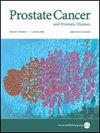活检时未检测到的楔形和导管内前列腺癌与不良预后有关。
IF 5.1
2区 医学
Q1 ONCOLOGY
引用次数: 0
摘要
背景:在前列腺活检和根治性前列腺切除术(RP)标本中,前列腺癌导管内癌(IDC)和楔形细胞形态(Crib)越来越被认为是不良预后的独立指标:我们的项目旨在评估这两种特征的假阴性活检对肿瘤预后的影响:研究纳入了2015年1月至2022年12月期间接受RP手术的患者。采用多变量考克斯比例危险模型对生化失败的预测因素进行了研究:在接受前列腺电切术的836名患者中,233人(27.9%)患有Crib,125人(15.0%)在前列腺活检中发现IDC,71人(8.5%)同时患有IDC和Crib。关于活检时的 IDC/Crib 状态,217 例(26%)患者的活检结果为假阴性,332 例(39.7%)患者的活检结果为真阴性,256 例(30.6%)患者的活检结果为真阳性,24 例(3.7%)患者的活检结果为假阳性。在比较IDC/Crib活检假阴性、假阳性、真阴性和真阳性时,我们发现IDC/Crib活检假阴性患者与IDC/Crib活检真阴性患者的病理分期(≥pT3)率是IDC/Crib活检真阴性患者的两倍:分别为56.8%和28.1%(P与真阴性活检相比,IDC/Crib 假阴性活检与更高的 BCR 风险和病理分期晚期独立相关。本文章由计算机程序翻译,如有差异,请以英文原文为准。

Undetected Cribriform and Intraductal Prostate Cancer at biopsy is associated with adverse outcomes
Intraductal carcinoma (IDC) and cribriform pattern (Crib) of prostate cancer are increasingly recognized as independent prognosticators of poor outcome, both in prostate biopsies and radical prostatectomy (RP) specimens. The aim of our project is to assess the impact of false negative biopsies for these two characteristics on oncological outcomes. Patients who underwent RP between January 2015 and December 2022 were included in the study. Predictors of Biochemical Failure were examined using a multivariate Cox proportional hazards model. Among the 836 patients who underwent RP, 233 (27.9%) had Crib, and 125 (15.0%) had IDC on prostate biopsy, with 71 (8.5%) patients having both IDC and Crib. Concerning IDC/Crib status at biopsy, 217 (26%) patients had a false-negative biopsy, 332 (39.7%) had a true-negative biopsy, 256 (30.6%) showed a true-positive biopsy, and 24 (3.7%) exhibited a false-positive biopsy, with respect to either pattern. When comparing false-negative, false-positive, true-negative and true-positive biopsies for IDC/Crib, we found that patients with a false-negative biopsy for IDC/Crib versus those with a true-negative biopsy for IDC/Crib disclosed a rate of advanced pathological stage (≥pT3) which was twice that of patients with a true-negative biopsy for IDC/Crib: 56.8% versus 28.1%, respectively (p < 0.001). On multivariate Cox analysis, log PSA before RP (hazard ratio [HR] 2.07, 95% CI 1.53–2.82; p < 0.001), a higher percentage of positive cores at biopsy ( ≥ 33%) (HR 1.68, 95% CI 1.07–2.63; p = 0.024), and false negative biopsy for IDC/Crib (HR 2.14, 95% CI 1.41–3.25; p < 0.001), were each significantly associated with an increased risk of BCR. A false-negative biopsy for IDC/Crib is independently associated with higher risk of BCR and advanced pathological stage compared to a true negative biopsy.
求助全文
通过发布文献求助,成功后即可免费获取论文全文。
去求助
来源期刊

Prostate Cancer and Prostatic Diseases
医学-泌尿学与肾脏学
CiteScore
10.00
自引率
6.20%
发文量
142
审稿时长
6-12 weeks
期刊介绍:
Prostate Cancer and Prostatic Diseases covers all aspects of prostatic diseases, in particular prostate cancer, the subject of intensive basic and clinical research world-wide. The journal also reports on exciting new developments being made in diagnosis, surgery, radiotherapy, drug discovery and medical management.
Prostate Cancer and Prostatic Diseases is of interest to surgeons, oncologists and clinicians treating patients and to those involved in research into diseases of the prostate. The journal covers the three main areas - prostate cancer, male LUTS and prostatitis.
Prostate Cancer and Prostatic Diseases publishes original research articles, reviews, topical comment and critical appraisals of scientific meetings and the latest books. The journal also contains a calendar of forthcoming scientific meetings. The Editors and a distinguished Editorial Board ensure that submitted articles receive fast and efficient attention and are refereed to the highest possible scientific standard. A fast track system is available for topical articles of particular significance.
 求助内容:
求助内容: 应助结果提醒方式:
应助结果提醒方式:


